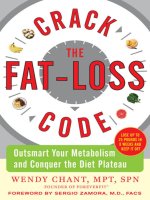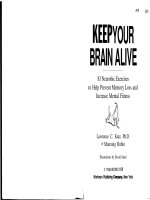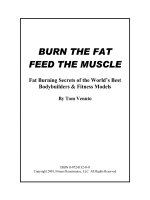47 contest prep fat loss agents 1
Bạn đang xem bản rút gọn của tài liệu. Xem và tải ngay bản đầy đủ của tài liệu tại đây (939.55 KB, 41 trang )
UNIVERSITY
Contest Prep
PEDs Fat Loss Agents:
Part 1 Thyroid Hormones
Lesson Overview Contest Prep Fat Loss Agents
PART 1 THYROID HORMONES
• PED deployment overview
• Mechanism of action
• How are thyroid hormones regulated
• Symptoms of hypothyroidism and lab interpretation
• Safety of use
• Contest prep effects on thyroid
• Thyroid protocols for contest prep
PART 2 CLENBUTEROL
• Mechanism of action
• Skeletal muscle anabolism
• Clenbuterol as a fat loss agent
• Managing clenbuterol side effects and safety
• Clenbuterol protocol for contest prep
PART 3 YOHIMBINE HCl
• Mechanism of action
• Yohimbine impact on adipose and skeletal muscle
• Caffeine synergy
• Gender differences
• Side effects and safety
• Yohimbine protocol for contest prep
• Summary of Fat loss Agent in Contest Prep
• Timing of Compounds for Contest Prep
PED Deployment
Anabolic Androgenic Steroids
Ancillary Compounds
Testosterone Based
Testosterone
Boldenone**
Halotestin*
Dianabol*
Estrogen and Fertility Management
Anastrozole*
Extremestane*
Nolvadex*
Clomid*
HCG
Dihydrotestosterone Based
Primobolan
Masteron
Anavar
Proviron
Winstrol*
Anadrol*
Nandrolone (19-Nor) Based
Nandrolone
Trenbolone*
Peptide Hormones
Growth Hormone
Blood Glucose
Metformin
Slow and Fast Insulin*
Blood Pressure
ARBs PPAR y-agonist Telmisartan
Fat Loss Agents
Clenbuterol*
T3/T4*
Yohimbine HCl*
No asterisk = frequent use allowable; and have been or currently in human clinical use.
*Phase Dependent Drug to deploy conditionally due to necessity, goal and/or safety risk, have
been or currently in human clinical use.
**Not approved for Human Use, rare situation deployed
Thyroid Actions
•
•
•
•
•
•
•
•
Metabolic function for basal metabolic rate
Generation of heat
Increased oxygen uptake in tissues
Increased sensitivity to catecholamines (heart)
Carbohydrate absorption in gut
Regulates protein and fat metabolism
Regulates calcium and phosphorus metabolism (bone health)
Synthesis and degradation of cholesterol and triglycerides (heart)
Signs and Symptom of Low Thyroid Hormone
•
•
•
•
•
•
•
•
•
•
•
•
•
•
Constipation
Headaches
Dry skin
Menstrual irregularities
Fluid retention
Anxiety
Lack of concentration
Reduced heart rate and blood pressure
Decrease sex drive
Cold intolerance
Insomnia
Low Body temp
Hair loss
High CRP
Hypothalamic Pituitary Thyroid Axis
(Freitas, 2012)
The Thyroid Hormones
Thyroid Stimulating Hormone (TSH): Considered standard for evaluating thyroid function,
poor measure for active thyroid hormone. Released from Pituitary to stimulate thyroid gland
production of T3 and T4.
High TSH= low T3 and T4 levels
Low TSH= high T3 and T4 levels
Free T4(Thyroxine): active hormone not bound to protein carrier indicating thyroid response
to TSH
• T4 has little physiological activity
• T4 must convert to T3 (takes place in liver(64%), GI (20%) and kidneys)
Free T3 (Triiodothyronine): active hormone not bound to protein carrier indicating response
to TSH and conversion of T4 to T3
• 90% of the thyroid hormone molecules that bind with the receptors are T3 and 10% are T4
Reverse T3: inactive isomer of T3. High normal or elevated reverse T3 is indicative of
reduced thyroid transport, most common in chronic and acute dieting
Thyroid peroxidase (TPO): Enzyme needed for thyroid production in thyroid gland
5’deiodinase: enzyme needed for conversion of T4 to T3, selenium dependent
Thyroid Antibodies (anti-TPO, Antithyroglobulin, anitimicrosomal antibody)
Thyroid binding globulin (produced by liver) estrogen increases
Thyroid Dysfunction
General hypothyroidism
• Adrenal dysfunction can occur along with hypothyroidism
• Thyroid antibodies can be present along with adrenal cortex
antibodies (autoimmune driven hypothyroidism)
• Cortisol levels may elevate to compensate for low T3
• Many disease states present to alter thyroid function
• ~50% of hypothyroidism is related to autoimmune disorder
Hashimoto’s thyroiditis
• Focus for us is within a contest prep setting
Thyroid Dysfunction
Thyroid Dysfunction and Contest Prep Dieting
• Calorie restriction decreases T3 up to 30%, likely related to energy
availability (Calorie intake vs expenditure vs body fat level)
• During low energy availability HPTA adapts to reduce energy
expenditure
• Caloric restriction increases proton leak across mitochondrial
membrane via uncoupling proteins with thyroid hormone modulating
the magnitude of proton leak, low TH decreased proton leak (Trexlar
2014)
• Only 4 days of low energy availability (30 vs 8kcal/kg FFM/day) can
decrease free T3 by 18% and increase reverse T3 by 24% (Elliott-Sale
2018)
• Athletes with amenorrhea show consistent decrease T3 levels, but T4
and TSH can range
Stress
• Increased thyroid binding protein, so T3 can not get in cells
• Decrease T4 to T3
• Decreased sensitivity to thyroid hormones
• Decreased immune barrier of GI tract via cortisol, resulting in
inflammation and dysbiosis
• Decreased HPTA communication to thyroid
Natural Bodybuilding Competition Preparation and
Recovery: A 12-Month Case Study (Rossow 2013)
6-month before and after drug free male bodybuilder competition
Reduction in T4 to T3 Conversion
Requires the enzyme 5’ Deiodinase
Causes:
• Selenium deficiency
• Stress
• Starvation (caloric restriction)
• Elevated cortisol
• Manage your fatigue
• Decreased kidney and liver function (contains 5’deidinase)
•
•
•
•
•
•
•
•
• Manage liver and kidney health
Iodine deficiency (composes structure of T3 and T4)
Beta blockers
Birth control pills
Estrogen
High cruciferous veggie intake (inhibit TPO)
Soy (inhibit action of TPO and decrease thyroid synthesis)
Low carb or low-fat diet
Inadequate DHEA
Where does the T4 go if not to T3?
Reverse T3
Most pertinent change in contest prep (high stress, inflammation, low
energy availability)
Why does it happen?
The transporter for T4 is more energy dependent than the transporter for
T3. High normal or elevated reverse T3 levels are the best measure of
thyroid transport into the cell.
What does it mean?
Reverse T3 competes with T3 for binding sites on cells
T3 will activate receptor sites, reverse T3 will not
Consider looking at free T3 to reverse T3 ratio. Excess rT3 (stored thyroid
hormone) will further inhibit conversion from T4 to T3.
If rT3 is high you can have symptoms of hypothyroidism, even if labs are
normal
Thyroid Lab Optimal Ranges
Optimal ranges:
TSH (mIU/L)
0.3-5.5 (N)
want below 2.0 (optimal)
>2.0 increased risk for hypothyroidism next 20 years and frequency of
thyroid anti-bodies
>4 increased risk heart disease
FT3
2.3-4.3 (N) pg/ml
3.5-4.3 (optimal)
rT3
90-350 pg/ml (N)
50-150 (optimal)
Smith, P., What You Must Know About Thyroid Disorders. Garden City
Park, NY: Square One Publishers, 2016.
How to Increase T4 to T3 Conversion
•
•
•
•
•
•
•
•
•
Selenium (cofactor for 5’-deiodinase) 75-200mcg/day
Iodine (150mcg per day US Institute of Medicine recommendation)
Iron (Ferritin level over 100ng/ml) (iron needed for TPO to function)
Zn (may reduce thyroid antibodies) 10-40mg/day
Ashwagandha 700mg/day
Growth Hormone
Testosterone (decreases thyroid binding globulin)
Melatonin
Reduce cruciferous vegetables and soy intake
Thyroid Protocol Consideration
How much produced?
• 10-22 micrograms T3 and 94-110 micrograms T4 daily (Miot 2021)
• Common to replace T4 and T3 together (lab results same, patients
report feeling better)
• About 70% of the T4 secreted daily is deiodinated to yield T3 + rT3 in
equal parts. Consider using both T3 and T4.
• In low energy availability T4 to T3 conversion limited, consider T3
alone.
Safety?
• 17-year observation study, “tears study”: 400 people 17 years, no
increased risk with T3 vs T4 usage for Atrial fibrillation CVD or
fractures (Leese 2016)
• Removal of T3 after 10 years of use, “Serum thyroxine concentration
returned to normal at least four weeks after hormone withdrawal”
(Vagenakis 1975)
Thyroid Protocol Consideration
Types of Compounds:
• T4 (Synthroid/Levothyroxine Sodium)
• T3 (Cytomel/Liothyronine Sodium)
• (Desiccated Thyroid) Armor ratio T4/T3, 4 to 1 (38mcg/9mcg)
Thyroid Timing
• Should be taken on an empty stomach. No food one hour before or
one hour after taking.
• No vitamins during this time frame either.
• Calcium interferes with the absorption of thyroid replacement.
• Single dosing is normal, however split dosing may alleviate any side
effects present
• 2.5 day half life
Human research of T3?
Ranging doses 40mcg to 150mcg (Kelly 2009)
Thyroid Protocol Bodybuilding Application
Contest Prep
Start of Prep
• Manage fatigue to preserve thyroid function long as possible
• Avoid drastic energy deficits <35% calorie below maintenance
• Selenium at 100mcg per day
• Iodine 150mcg per day (if not using iodized salt)
• Zn 20mg per day
Mid prep or when fatigue is recognized (sleep change, fat stall, GI
disturbance, libido change, water retention, etc)
• Lab work evaluate TSH, FT3, FT4, rT3
• Ashwagandha 700mg at night
• T3 starting dosing at 15-25mcg as a replacement dosage
• *see optimal lab range slide
• *higher dosing is not indicated
• *implement ONLY if needed
Post Show
• Discontinue T3, do NOT taper, continued T3 supplementation is
continued thyroid suppression
• Continue Zn, Selenium, Iodine, Ashwagandha
UNIVERSITY
Contest Prep
PEDs Fat Loss Agents:
Part 2 Clenbuterol
Lesson Overview Contest Prep Fat Loss Agents
PART 1 THYROID HORMONES
• PED deployment overview
• Mechanism of action
• How are thyroid hormones regulated
• Symptoms of hypothyroidism and lab interpretation
• Safety of use
• Contest prep effects on thyroid
• Thyroid protocols for contest prep
PART 2 CLENBUTEROL
• Mechanism of action
• Skeletal muscle anabolism
• Clenbuterol as a fat loss agent
• Managing clenbuterol side effects and safety
• Clenbuterol protocol for contest prep
PART 3 YOHIMBINE HCl
• Mechanism of action
• Yohimbine impact on adipose and skeletal muscle
• Caffeine synergy
• Gender differences
• Side effects and safety
• Yohimbine protocol for contest prep
• Summary of Fat loss Agent in Contest Prep
• Timing of Compounds for Contest Prep
Clenbuterol
General Overview
Anti-asthma medication, sympathomimetic
Sympathetic nervous system contains 2 main chemical signalers
(epinephrine and norepinephrine)
Increased during high stress
Adrenal gland secretion increases cardiac output and glucose production
Adrenergic Receptors
Action mediated via adrenergic receptors (9 different types present)
Alpha 1 (1A, 1B, 1C), Alpha 2 (2A, 2B, 2C), Beta (1,2,3)
Beta (1) related to cardiovascular function and lipolysis
Beta (2) actions in skeletal muscle anabolism (highest content in relation
to other subunits) and adipose tissue lipolysis
Beta (3) primarily in adipose tissue and stimulation increase lipolysis
Clenbuterol Receptor Action
Primary action of Clen is selective to the Beta 2 receptors with some
action on the B3 receptor
Little beta 1 activity making it favorable to reduce airway obstruction with
lessen cardiac effects making it an effective bronchodilator
Long half like of 34 hours, single daily dosing is effective
Beta 2 receptor stimulation directly on adipose tissue and liberalize fatty
acids via increased in adenylyl cyclase leading to an increase in cyclic
adenosine monophosphate and protein kinase A(PKA). This action is
turning on the cell’s energy status pathway. PPAR alpha activation and
UCP1 increasing fatty acid oxidation
Beta 2 activation in decrease protein degradation and potential increase
in protein synthesis.
Downregulation occurs quickly in skeletal muscle, but this does not mean
a decrease in fatty acid oxidation.
Clenbuterol Skeletal Muscle Action
mTOR activation mechanism
Fasted administration of 80mcg of clenbuterol 6 healthy men.
21% increase in Resting energy expenditure and 39% increase in fat
oxidation. Phosphorylation of mTOR increased by 121% and PKA
increased by 35%. (Jessen 2020)
Muscle/Fat Mass in Surrogate studies
In protein deficient animals, clenbuterol treatment may help conserve
body protein at the expense of fat
In rats fed a normal (22% protein) diet, injection of clenbuterol (1
mg/kg/d for 21 d) (Rothwell 1987) resulted in a smaller but leaner body
mass
Strength in Humans
Study in 20 healthy male patients. Patients were treated with 40mcg of
Clenbuterol drug or placebo for 4 weeks postoperatively
Muscle strength and cross-sectional area were determined before and
after surgery (medial meniscectomy), Clenbuterol associated more rapid
recovery in strength in knee extensor muscles. (Maltin, 1993)
Clenbuterol Skeletal Muscle Action
Muscle Mass Humans
Other agents in same class as clenbuterol have shown hypertrophy in
humans.
Inhaled Terbutaline, 76 participants, 4 weeks, (8x0.5mg) or placebo
treatment w/o concurrent training, with resistance training, or with
endurance training 3x per week. Terbutaline increased lean body mass by
1.03kg and 1.04kg compared to the placebo in concurrent and resistance
training group but not in the endurance group. (Jessen, 2018)
71 patients, brachial plexus injuries given 60mcg Clen 2x per day or
placebo 3 months. Effect on attenuating muscle atrophy. Clen mitigated
the decrease in cross sectional area of muscle fiber. (Jiang 2011)
Receptor Down Regulation
After 18 days administration there was 50% downregulation in Beta-2
receptors and 80% decrease in blood flow in skeletal muscle
However, a 5-fold increase in white and brown adipose tissue blood flow
is seen. Indicative chronic usage continues to increase lipolytic and
thermogenic activity despite effects on skeletal muscle dissipating.
(Rothswell, 1987)
Clenbuterol in Clinical Setting
Clenbuterol is not approved for usage in the USA
Clenbuterol is approved in Europe and Latin America world and has
undergone human safety trials.
20mcg tablets most common
In asthma 20mcg twice per day is common (40mcg) , up to 40mcg
twice per day (80mcg)
Clenbuterol Side Effects
CNS stimulation induced:
Tremors
• Increase is natural tremor of body and awareness occurs
• Overstimulation of Beta receptor
• Hypokalemia
• Muscle Cramps associated with Clenbuterol via K depletion and cell volume shrinkage
(Moratinos 1993)
• B2 desensitization occurs rapidly and tremors resolve with normal usage
• Clenbuterol for 18 days there was a 50% reduction in Beta2 density in muscle,
explaining development of tolerance to tremors(Rothwell 1987)
Insomnia
Sweating
Increased blood pressure
Nausea









